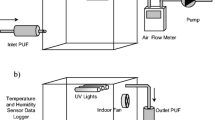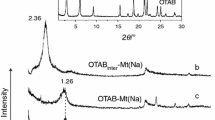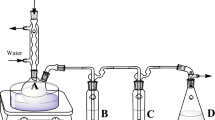Abstract
The impact of modified montmorillonites on adsorption and biodegradation of crude oil C1-phenanthrenes, C1-dibenzothiophenes, C2-phenanthrenes and C2-dibenzothiophenes was investigated in aqueous clay/oil microcosm experiments with a hydrocarbon degrading microorganism community. Consequently, the effect on C1-dibenzothiophenes/C1-phenanthrenes, C2-dibenzothiophenes/C2-phenanthrenes, 2+3-methyldibenzothiophene/4-methyldibenzothiophene and 1-methyldibenzothiophene/4-methyldibenzothiophene ratios commonly used as diagnostic ratios for oil forensic studies was evaluated. The clay mineral samples were treated to produce acid activated montmorillonite, organomontmorillonite and homoionic montmorillonite which were used in this study. The different clay minerals (modified and unmodified) showed varied degrees of biodegradation and adsorption of the C1-phenanthrenes, C1-dibenzothiophenes, C2-phenanthrenes and C2-dibenzothiophenes. The study indicated that as opposed to biodegradation, adsorption has no effect on the diagnostic ratios. Among the diagnostic ratios reviewed, only C2-dibenzothiophenes/C2-phenanthrenes ratio was neither affected by adsorption nor biodegradation making this ratio very useful in forensic studies of oil spills and oil–oil correlation.







Similar content being viewed by others
References
Bao JP, Zhu CS (2009) The effects of biodegradation on the compositions of aromatic hydrocarbons and maturity indicators in biodegraded oils from Liaohe Basin. Sci China Ser D-Earth Sci 52:59–68
Bennett B, Chen M, Brincat D, Gelin FJP, Larter SR (2002) Fractionation of benzocarbazoles between source rocks and petroleums. Org Geochem 33:545–559
Bright JJ, Fletcher M (1983) Amino acid assimilation and electron transport system activity in attached and free living marine bacteria. Appl Environ Microbiol 45:818–825
Burger AE (1993) Estimating the mortality of seabirds following oil spills: effects of spill volume. Mar Pollut Bull 26(3):140–143
Burns KA, Garrity SD, Levings SC (1993) How many years until mangrove ecosystems recover from catastrophic oil-spills. Mar Pollut Bull 26:239–248
Carter DL, Heilman MD, Gonzalez CL (1965) Ethylene glycol monoethyl ether for determining surface area of silicate minerals. J Soil Sci 100(5):356–360
Chaerun SK, Tazaki K (2005) How kaolinite plays an essential role in remediating oil-polluted seawater. Clay Miner 40:481–491
Chakhmakhchev A, Suzuki M, Takayama K (1997) Distribution of alkylated dibenzothiophenes in petroleum as a tool for maturity assessment. Org Geochem 26:483–489
Chiou CT, Rutherford DW (1997) Effects of exchanged cation layer charge on the sorption of water and EGME vapours on montmorillonite clays. Clays Clay Miner 45(6):867–880
Churchman GJ, Gates WP, Theng BKG, Yuan G (2006) Clays and clay minerals for pollution control. In: Bergaya F, Theng BKG, Lagally G (eds) Handbook of clay science: developments in clay science, vol 1. Elsevier, Amsterdam
Cornejo J, Celis R, Pavlovic I, Ulibarri MA (2008) Interactions of pesticides with clays and layered double hydroxides: a review. Clay Miner 43:155–175
Das K, Mukherjee AK (2006) Crude petroleum-oil biodegradation efficiency of Bacillus subtilis and Pseudomonas aeruginosa strains isolated from a petroleum-oil contaminated soil from North-East India. Bioresour Technol 98(7):1339–1345
Delille D, Coulon F (2008) Comparative mesocosm study of biostimulation efficiency in two different oil-ammended sub-antarctic soils. Microb Ecol 56:243–252
Dubikova M, Cambier P, Sucha V, Caplocicova M (2002) Experimental soil acidification. Appl Geochem 17:245–257
Environmental Agency (2006). http://www.environment-agency.gov.uk/commondata/103601/poll_incidents_2005_1438766.xls. Accessed Nov 2007
Fletcher M, MarshalL KC (1982) Are solid surfaces of ecological significance to aquatic bacteria? Adv Microbial ecol 6:199–236
Galan E, Carretero MI, Fernandez Caliani JC (1999) Effects of acid mine drainage on clay minerals suspended in the Tinto River (Rio Tinto, Spain). An experimental approach. Clay Miner 34:99–108
Groisman L, Rav-Acha C, Gerstl Z, Mingelgrin U (2004) Sorption of organic compounds of varying hydrophobicities from water and industrial waste-water by long- and short- chain organoclays. Appl Clay Sci 24:159–166
Guerin WF, Boyd SA (1992) Differential bioavailabilty of soil sorbed naphthalene to two bacterial species. Appl Environ Microbiol 58:1142–1152
Harayama S, Kirshira H, Yuki Kasai, Shutsubo K (1999) Petroleum biodegradation in marine environments. J Molec Microbiol Biotechnol 1(1):63–70
He H, Frost RL, Bostrom T, Yuan P, Duong L, Yang D, Xi Y, Kloprogge JT (2006) Changes in the morphology of organoclays with HDTMA+ surfactant loading. Appl Clay Sci 31:262–271
Hermosin MC, Ulibarri MA, Mansour M, Cornejo J (1992) Assaying sorbents for 2,4-dichlorophenoxyacetic acid from water. Fresenius Environ Bull 1:472–481
Jaynes WF, Boyd SA (1991) Hydrophobicity of siloxane surfaces in smectites as revealed by aromatic hydrocarbon adsorption from water. Clays Clay Miner 39:428–436
Komadel P (2003) Chemically modified smectites. Clay Miner 38:127–138
Lewis DR (1949) Analytical data on reference clay materials Sect. 3, base-exchange data, reference clay minerals. A.P.I. Research Project 49, Preliminary Report No. 7. Columbia University, New York
Lin Z, Puls RW (2000) Adsorption, desorption and oxidation of arsenic affected by clay minerals and aging process. Environ Geol 39:753–759
Liu J, Xu Z, Masliya J (2004) Role of fine clays in bitumen extraction from oil sands. AlChE J 50:1917–1927
Nikopolou M, Kalogerakis N (2009) Biostimulation strategies for fresh and chronically polluted marine environments with petroleum hydrocarbons. J Chem Technol Biotechnol 84:802–807
Oepen BV, Kordel W, Klein W (1991) Sorption of nonpolar and polar compounds to soils: processes and measurements and experience with the applicability of the modified OECD-Guideline 106. Chemosphere 22(3–4):285–304
Peters KE, Walters CC, Moldowan JC (2005) Applications of biomarkers and polycyclic aromatic hydrocarbons The Biomarker Guide Volume 1. Cambridge University Press, Cambridge
Radke M (1988) Application of aromatic compounds as maturity indicators in source rocks and crude oils. In: Advances in organic geochemistry, Butterworth & Co. Ltd, London
Reddy CR, Nagendrappa G, Jai Prakash BS (2007) Surface acidity study of Mn+-montmorillonite clay catalysts by FT-IR spectroscopy: correlation with esterification activity. Catal Commun 8:241–246
Schou L, Myhr MB (1983) Sulfur aromatic compounds as maturity parameters. Org Geochem 13:61–66
Shaw DG (1992) The Exxon-valdez oil-spill-ecology and social consequences. Environ Conserv 19(3):253–258
Stotzky G, Rem LT (1966) Influence of clay minerals on microorganisms I. Montmorillonite and kaolinite on bacteria. Can J Microbiol 12:547–563
Tazaki K, Chaerun SK (2008) Life in oil: hydrocarbon-degrading bacterial mineralization in oil spill-polluted marine environment. Frontier material science China 2(2):120–133
Theocharis CR, Jacob KJ, Gray AC (1988) Enhancement of Lewis acidity in layer aluminosilicates. J Chem Soc, Faraday Trans 84:1509–1516
van Aarssen BGK, Bastow TP, Alexander R (1999) Distribution of methylated naphthalenes in crude oils: indicators of maturity, biodegradation and mixing. Org Geochem 30:1213–1227
van Loosdrecht MCM, Lyklema J, Norde W, Zehnder JB (1990) Influence of interfaces on microbial activity. Mirobiol Rev 54:75–87
Vidali M (2001) Bioremediation. An overview. Pure Appl Chem 73(7):1163–1172
Wang Z, Fingas M, Sigouin L (2001) Characterization and identification of ‘mystery’ oil spill from Quebec (1999). J Chromatogr A 909:155–169
Wang Z, Stout SA, Fingas MF (2006) Biomarker fingerprinting for spill oil characterization and source identification. Environ Forensics 7(2):105–146
Warr LN, PerdriaL JN, Lett M, Heinrich-Salmeron A, Khodja M (2009) Clay mineral-enhanced bioremediation of marine oil pollution. Appl Clay Sci 46:337–345
Yurudu C, Isci S, Unlu C, Atici O, Ece OI, Gungor N (2005) Synthesis and characterization of HDA/NaMMT organoclay. Bull Mater Sci 28:623–628
Zhu D, Herbert BE, Schlautman MA, Carraway ER, Hur J (2004) Cation–π bonding: a new perspective on the sorption of polycyclic aromatic hydrocarbons to mineral surfaces. J Environ Qual 33:1322–1330
Acknowledgments
We thank Berny Bowler, Paul Donohue, Phil Green and Ian Harrison for the laboratory support received from them. Generally we are grateful to Petroleum Technology Development Fund (PTDF) of the Federal Republic of Nigeria for funding this project and the School of Civil Engineering and Geosciences of Newcastle University for providing the facilities used in this study.
Author information
Authors and Affiliations
Corresponding author
Rights and permissions
About this article
Cite this article
Ugochukwu, U.C., Head, I.M. & Manning, D.A.C. Biodegradation and adsorption of C1- and C2-phenanthrenes and C1- and C2-dibenzothiophenes in the presence of clay minerals: effect on forensic diagnostic ratios. Biodegradation 25, 515–527 (2014). https://doi.org/10.1007/s10532-013-9678-6
Received:
Accepted:
Published:
Issue Date:
DOI: https://doi.org/10.1007/s10532-013-9678-6




